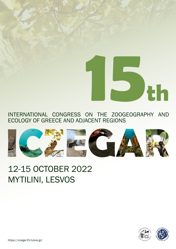General and local Information
Lesvos is one of the largest Aegean islands, with a surface area of 1,633 square kilometers. Most of the eastern part of the island is covered by olive groves, a very important crop on the island. Large areas of pine woodland exist mainly in the central part while the West of the island is largely covered by low shrubland with scattered patches of oak woodland.
Lesvos is an island well known for its rich biodiversity, including birds, insects such as dragonflies, and plants, including many wild orchid species. Lesvos is a popular destination for birdwatching, especially in the spring months. The island is also endowed with two lagoon-like shallow sea inlets, the Gulf of Gera in the East and the Gulf of Kalloni in the West, both well-known for their high biological productivity and rich marine life. Read more on the nature of Lesvos at the Kalloni Environmental Information Centre webpage and the Visit Lesvos website.
The western part of Lesvos is also well known for the petrified forest remains. A higher concentration of petrified trees is found around the area of Sigri, in the SW of the island. The Natural History Museum of the Lesvos Petrified Forest has splendid exhibits. Please note that collection of petrified wood is illegal.
You may also be interested to read about the culture of Lesvos and local culinary delights.
















